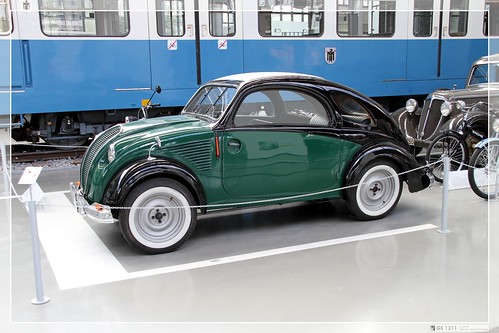1936 Steyr Typ 50 ‘Baby’ (02)
A few nice 9. twitter +50 % images I found:
1936 Steyr Typ 50 ‘Baby’ (02)

Image by GS1311
The Steyr 50 is a small car released in 1936 by the Austrian automobile manufacturer Steyr. The streamlined body was approved by Director Karl Jenschke to be constructed in 1935, but in that same year Jenschke relocated to the German Adlerwerke in Frankfurt/Main.
The car had a water-cooled four-cylinder boxer engine driving the rear wheels through a four-speed transmission. To save room and weight a dynastarter was used, which doubled as the axle of the radiator fan. It was regarded as the "Austrian Peoples’ Car" and was affectionately referred to as the Steyr "Baby". Professor Porsche had, despite rumors, not been involved in the design or production of the 50. Moreover, the little Steyr offered better seating and luggage space than Porsche’s Volkswagen with shorter overall length, a large sheet metal sliding roof and was available with hydraulic brakes (instead of the early Volkswagens’ cable-operated ones).
(Wikipedia)
- – -
Der Steyr 50 ist ein Kleinwagen, der von Steyr-Daimler-Puch A.G. ab 1936 produziert wurde.
Die stromlinienförmige Karosserie wurde noch von Karl Jenschke konstruiert, der bereits im November 1935 bei Adler in Frankfurt/Main den Posten des Chefkonstrukteurs übernahm. Der vorn eingebaute 4-Zylinder-Boxermotor mit Thermosiphon-Wasserkühlung trieb über ein 4-Gang-Getriebe mit Mittelschaltung die Hinterräder an. Er galt als österreichischer „Volkswagen" und wurde liebevoll „Steyr-Baby“ genannt. Ferdinand Porsche hatte – entgegen anderslautenden zeitgenössischen Gerüchten – mit dem Fahrzeug keinerlei Verbindung, obwohl Jenschke mit ihm zeitweilig in dienstlicher Verbindung stand, genauso wie mit Hans Ledwinka, der ab 1931 bei Tatra den Prototypen V-570 konstruierte.
(Wikipedia)
Map of top 50 UK PR twitter people and their followers

Image by Porter Novelli Global
Spurred on by some of the comments we’ve received about the Rufus map we made of the top 50 UK PR twitter people (as measured by Stephen Waddington) I thought it’d be a good idea to look at this in a bit more depth. Rufus isn’t really the right tool for looking at this, so we’ve built something else to do it better. Looking at one site or service is a lot easier than looking at lots of sites — so this took hours, not months to create.
After a little debugging we were ready to test on a seedlist of 50. The crawl took about an hour to run.
This is a visualization of the data set we got (correct as at December 12, 2008) after very little processing.
Size of blobs relates roughly to "how many people in the group follow you."
And we’ve removed anyone who is only followed by one person in the group. So everyone here is followed by at least two others (obviously.)
There are just too many people in this graph to show labels. And a lot of the top 50 people are hidden by other top 50 people. Maybe I should do a graph rotating in 3D.
What I’ll do over the weekend is process the data files I’ve got (one’s got around 30K records, and the other 40K records) to see if we can tease a little more information out of them.
This is a very high def image, so it will blow up nicely.
Oh — and Rufus is a project that Porter Novelli has been working on.
For more on this, see this post on Twitter Social Network Analysis
Leave a Reply